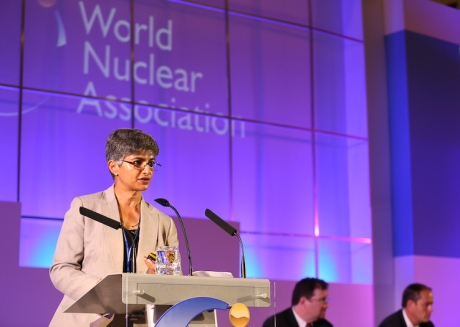World nuclear capacity is set to continue to grow, but the supply of uranium should meet predicted demand for the next several years according to the latest World Nuclear Association (WNA) report on the nuclear fuel market, released today at its Annual Symposium in London.
 |
| Sashi Davies presents the report at the WNA Annual Symposium |
In the report, The Global Nuclear Fuel Market: Supply and Demand 2013-2030, the WNA expects demand for uranium to increase considerably up to 2030, resulting in a substantial need for additional supplies of nuclear fuel. In the WNA's most optimistic scenario (referred to as the upper scenario), uranium demand would reach 119,000 tU by 2030, from today’s level of 62,000 tU, and about 97,000 tU in the reference scenario. Provided that all uranium mines currently under development enter service as planned, the report finds that the uranium market should be adequately supplied to 2025; beyond this time new mines need to be operating.
Compared with the previous edition of The Global Nuclear Fuel Market in 2011, both the upper and reference scenario for uranium requirements are significantly lower in the period to 2030, but the lower scenario (59,000 tU in 2030 in the latest edition) is overall little changed. Despite the lower rate of nuclear growth, the sector will nevertheless grow at a faster rate than at any time since 1990, leading to a substantial need for additional supplies of uranium.
The report was introduced by Exelon's Jim Nevling and Sashi Davies of Extract Resources, on behalf of the WNA's drafting committee.
Although the supply of uranium is projected to meet demand, a gap between supply and demand in conversion services starts to emerge post-2017. Conversion is an essential part of the nuclear fuel cycle, where chemical processes convert the uranium (after it has been mined and milled) to uranium hexafluoride, which is a form of uranium that can be enriched in the next stage of the nuclear fuel manufacturing process. Co-presenting the report on behalf of the WNA's drafting committee, Sashi Davies of Extract Resources explained that it is assumed that conversion plants are currently running at about 70% capacity. Beyond 2017, they will need to use more of their capacity to meet requirements, she said. The report notes that running existing conversion plants at their maximum capacity will not be sufficient over the long term, and new capacity or life extensions to current facilities will be needed to ensure uranium hexafluoride production continues to meet demand.
Nuclear capacity projections
The lower projected rate of growth of the nuclear sector in the latest edition of the WNA market report (compared with the 2011 edition) reflects the current and expected increased level of challenges facing utilities aiming to commission new nuclear power plants. These challenges are not only a result of the post-Fukushima calls for the industry to demonstrate higher levels of safety, but also the need to cope with stronger competition from alternative generating technologies at a time of more modest power demand growth expectations.
Davies's co-presenter, Exelon's Jim Nevling, explained that although the growth rate is lower than in the previous edition, an overall increase of capacity of 70% expected by 2030 would be seen as good by any industry. "It's still a relatively positive outlook," he said.
In the report’s reference scenario, global nuclear generating capacity is projected to increase from 334 GWe today to 574 GWe by 2030, an annual growth rate of 3.0%. The calculation includes an assumed reopening schedule for Japanese reactors not included in the 2013 capacity total. The more optimistic upper scenario envisages a 4.2% rate of growth, so that total nuclear capacity reaches 700 GWe in 2030, whereas the lower scenario assumes 0% growth, with nuclear capacity at 341 GWe in 2030.
Researched and written
by World Nuclear News




_18570.jpg)
_16159.jpg)
_49205.jpg)
_18938.jpg)





